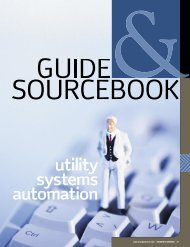CEO Turnover - Description
CEO Turnover - Description
CEO Turnover - Description
Create successful ePaper yourself
Turn your PDF publications into a flip-book with our unique Google optimized e-Paper software.
we are entitled to significant rate rollbacks under properly<br />
applied STB ratemaking standards and will present our<br />
argument to the STB later this year.<br />
Following massive industry consolidation, only four major<br />
railroads remain in the United States — only two of which<br />
are in the West: BNSF and the Union Pacific Railroad. Their<br />
increasing resistance to offer reasonable rates and service<br />
terms to their customers has stimulated shipper unrest, which is<br />
manifest in the work of the Alliance for Rail Competition (ARC)<br />
and Consumers United for Rail Equity (CURE). These two<br />
shipper coalitions urge Congress to provide meaningful regula-<br />
tory relief for captive shippers. Coalition participants represent<br />
a wide range of industries and include Edison Electric Institute,<br />
American Public Power Association, and the National Rural<br />
Electric Cooperative Association.<br />
What ARC and CURE intend, claims Association of<br />
American Railroads’ <strong>CEO</strong> Ed Hamberger, is nothing less<br />
than re-regulation of the railroads — as though railroads<br />
operate in a free market devoid of regulation. In actuality,<br />
they don’t. The railroads have lobbied hard to maintain<br />
status quo regulatory protections that allow them to stave<br />
off competition and engage in the kind of monopolistic<br />
pricing practices that led to the kind of greater than 200<br />
percent rate markup imposed by BNSF on the LRS coal<br />
movement. It should be clear that the railroads function<br />
as monopolists across a broad sector of their business.<br />
In fact, many of the railroads’ customers perceive an<br />
attitude from the railroads that they do not exist to serve<br />
customers’ reasonable service needs. Rather, they treat<br />
their customers as if their purpose is to serve the railroads’<br />
profit-maximizing needs. The railroads all but admit it.<br />
With the advent of railroad deregulation 25 years ago<br />
from passage of the Staggers Rail Act, Congress attempted<br />
to promote railroad competition where possible and leave<br />
backstop rate protections in place for captive shippers.<br />
However, the Staggers Act’s core principles — the protection<br />
of rail customers who are dependent upon a single railroad for<br />
service and the promotion of rail-to-rail competition — gradu-<br />
ally have been whittled away. A groundswell of railroad custom-<br />
ers perceive a fundamental market imbalance on the regulatory<br />
playing field. Something clearly needs to be done.<br />
A potential remedy is contained in legislation jointly<br />
advocated by ARC and CURE. The “Railroad Competition<br />
Act” will be re-introduced in the 109th Congress and is<br />
intended to clarify national rail policy by defining primary<br />
objectives for the STB. The clearly stated objectives are:<br />
(1) ensuring effective competition among rail carriers at<br />
origins and destinations; (2) maintaining reasonable rates<br />
in the absence of effective competition; and (3) maintain-<br />
ing consistent and efficient rail transportation for rail<br />
shippers, including the timely provision of rail cars.<br />
Other major provisions require railroads to quote rates to<br />
their customers over so-called “bottleneck” line segments.<br />
Railroads strongly resist this approach for fear of opening up<br />
their systems to more competition. The proposed legislation also<br />
would remove so-called “paper barriers” that prevent short-line<br />
or regional railways from competing with the major railroads<br />
that spun them off. It would free up terminal access provisions<br />
imposed by statute and rendered unusable by subsequent<br />
STB decisions and those of its predecessor, the Interstate<br />
Commerce Commission. It also would permit a governor to<br />
declare all or part of a state to be an area of inadequate rail<br />
competition, triggering special rail customer remedies.<br />
These rather modest legislative remedies do not create<br />
a new tier of regulation. Instead, they seek to make more<br />
effective laws and legal principles that already are in place.<br />
The legislation does not nationalize the railroads or grant a<br />
competitor new rights to move its trains over another railroad’s<br />
tracks. It’s neither radical nor re-regulatory. It’s simply a remedy<br />
well within the bounds of the American free-market system as<br />
it has evolved to control anti-competitive behavior.<br />
The Western Fuels Association and its members are<br />
threatened by the BNSF’s behavior. Circumstances at<br />
the LRS appear to be only the first in a chain of contract<br />
reopeners Western Fuels’ members can experience<br />
over the next few years. We intend to fight for our rights<br />
under the regulatory system as it exists today. We will do<br />
everything we can to make that system more hospitable to<br />
the real needs of captive shippers.<br />
Western Fuels, its members, and utilities nationwide<br />
rely on coal as the source of more than half of the electricity<br />
they generate. Coal-reliant utilities require healthy, profitable<br />
railroads as partners in providing electricity, which has<br />
become the economy’s primary source of energy outside<br />
the transportation sector since the mid-1980s. Given<br />
railroad business plans that rely upon maximum revenues<br />
from coal traffic, it is clear the railroads need utility and coal<br />
producer business if they are to survive. The nation needs<br />
coal to continue its role as a reliable, affordable and increas-<br />
ingly clean source of energy for electricity generation. Such<br />
interdependence cannot thrive in today’s anti-competitive<br />
environment for coal transportation.<br />
Duane L. Richards is chief executive<br />
officer of the Western Fuels Association,<br />
which delivers 17 million tons of coal<br />
per year to consumer-owned utility.<br />
News Flash>><br />
www.energycentral.com<br />
CARBON TRADE<br />
LAUNCH<br />
Billions of dollars<br />
of carbon credits<br />
are expected to be<br />
traded in a newly<br />
launched European<br />
commodity market.<br />
News reports stated<br />
that 12,000 facilities<br />
on the continent are<br />
being told what their<br />
allowable emissions<br />
levels will be.<br />
Those that come<br />
under the limit can<br />
sell their credits<br />
- one credit per<br />
ton of carbon.<br />
Official trading<br />
began this year and<br />
has grown to roughly<br />
400,000 tons daily.<br />
The procedure is<br />
part of the Kyoto<br />
Protocol which<br />
went into effect in<br />
February. Europe is<br />
a participant; the<br />
United States is not.<br />
www.energycentral.com ENERGYBIZ MAGAZINE 15


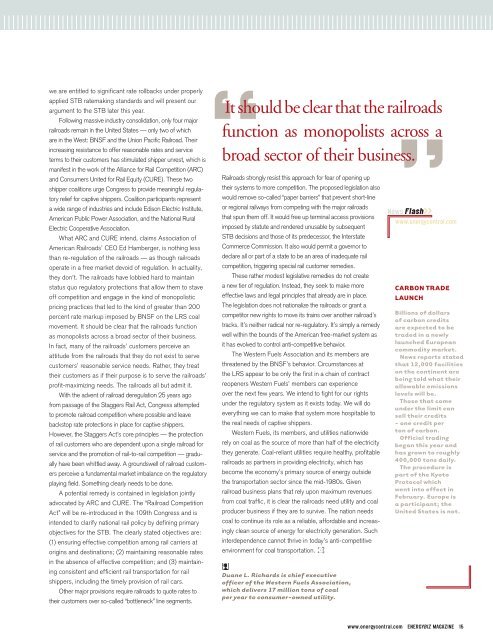
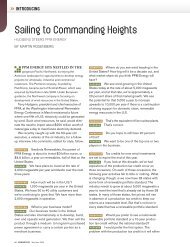

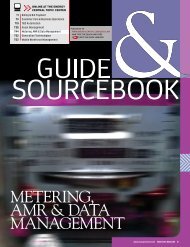

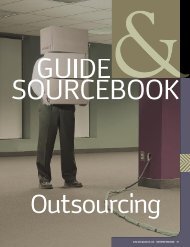




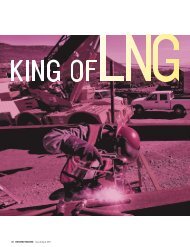


![View From the Trenches [PDF]](https://img.yumpu.com/18854438/1/190x252/view-from-the-trenches-pdf.jpg?quality=85)
